Geoff Nicholson's Blog, page 40
December 11, 2017
BALLS AND SPOTLIGHTS
I was walking in LA, by the Beverly Center, which has been refurbished at a cost of $500 million and does look very slightly better than it did before, and I looked in the window of Macy’s and took a picture, arguably a selfie. (The “foregrounding” of the gut is caused by the nature of spherical reflections, honest.):

And then I started thinking of a picture I took when I was walking in Greece near the (unrefurbished) Acropolis some forty years ago. See how my aesthetic focus has remained stable (i.e. undeveloped) over the years. And yes, I know there was never any excuse for the tie-dye and those shorts.
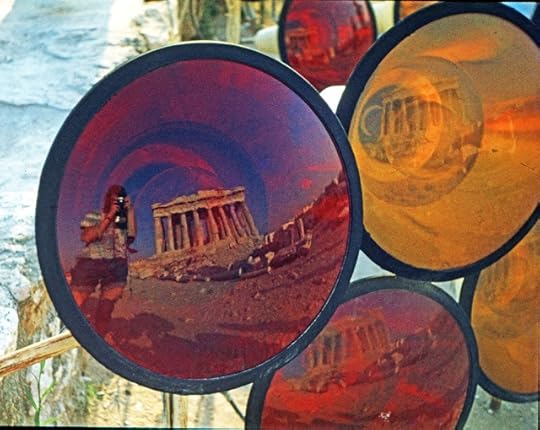


And then I started thinking of a picture I took when I was walking in Greece near the (unrefurbished) Acropolis some forty years ago. See how my aesthetic focus has remained stable (i.e. undeveloped) over the years. And yes, I know there was never any excuse for the tie-dye and those shorts.


Published on December 11, 2017 09:32
December 7, 2017
OUR BREWS ARE IN THE GUTTER
You can walk a long way before you see this kind of thing. I’d walked as far as Dayton Way, which is in Beverly Hills. Posh area, right.
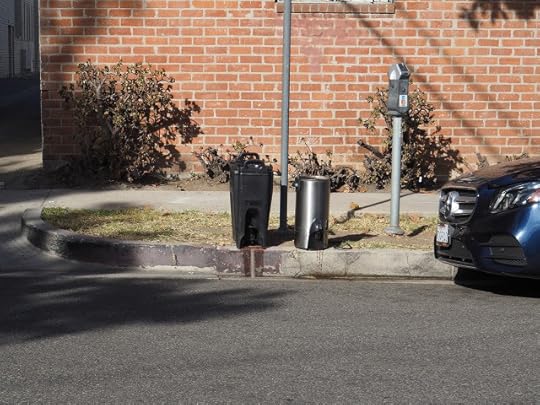
And I saw these two things at the side of the road, one black and one silver, and there was absolutely nobody around and I thought they’d been dumped there, and it's possible that they had, but they’d evidently been in use till very, very recently, and in fact it seemed they still contained coffee (at least it definitely looked like coffee) which was even now pouring out into the gutter.
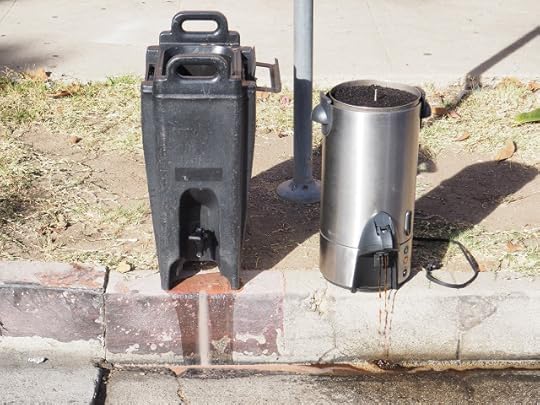
I’m sure there was a story here, an explanation, but I reckon it was probably far less intriguing than the sight of them just sitting there, dispensing coffee into oblivion.
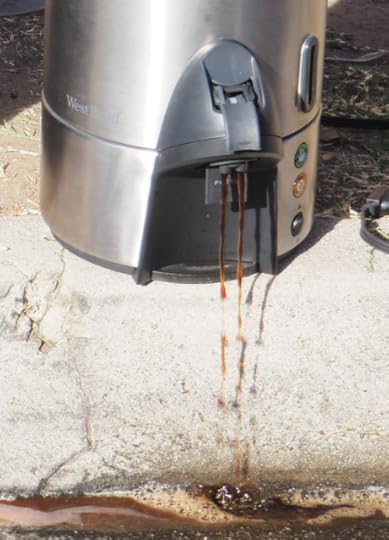


And I saw these two things at the side of the road, one black and one silver, and there was absolutely nobody around and I thought they’d been dumped there, and it's possible that they had, but they’d evidently been in use till very, very recently, and in fact it seemed they still contained coffee (at least it definitely looked like coffee) which was even now pouring out into the gutter.

I’m sure there was a story here, an explanation, but I reckon it was probably far less intriguing than the sight of them just sitting there, dispensing coffee into oblivion.


Published on December 07, 2017 17:27
OUR GRAINS ARE IN THE GUTTER
You can walk a long way before you see this kind of thing. I’d walked as far as Dayton Way, which is in Beverly Hills. Posh area, right.

And I saw these two things at the side of the road, one black and one silver, and there was absolutely nobody around and I thought they’d been dumped there, and it's possible that they had, but they’d evidently been in use till very, very recently, and in fact it seemed they still contained coffee (at least it definitely looked like coffee) which was even now pouring out into the gutter.

I’m sure there was a story here, an explanation, but I reckon it was probably far less intriguing than the sight of them just sitting there, dispensing coffee into oblivion.



And I saw these two things at the side of the road, one black and one silver, and there was absolutely nobody around and I thought they’d been dumped there, and it's possible that they had, but they’d evidently been in use till very, very recently, and in fact it seemed they still contained coffee (at least it definitely looked like coffee) which was even now pouring out into the gutter.

I’m sure there was a story here, an explanation, but I reckon it was probably far less intriguing than the sight of them just sitting there, dispensing coffee into oblivion.


Published on December 07, 2017 17:27
December 5, 2017
WALKING ON CARPET

I was walking past a used car lot on Hollywood Boulevard, and being the language obsessive that I am, my eye was drawn to the words displayed on the windshields of the cars; shout lines, I suppose, or possibly selling lines. All of them were hand painted in good old fashioned signwriters’ script, the kind of thing you used to see on the windows of butchers and fruit shops. You, or I, might have thought it was a dead art, but evidently not.

This was cheering in some small way but then I started wondering, did the person who did the painting have to come up with the words? If not, who did? Some hotshot salesman who think he knows what sells?
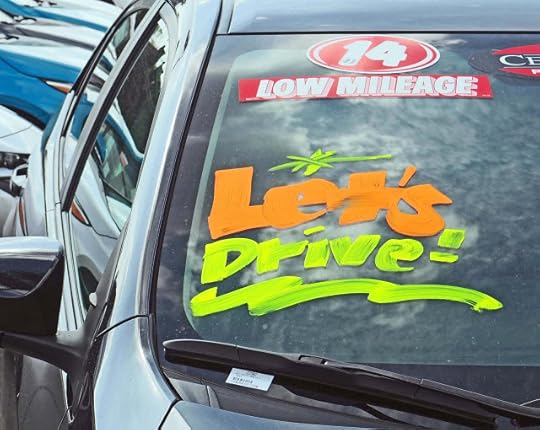
And of course I also wondered whether the company had a stock of generic phrases that they used over and over again, or whether they were constantly trying to come up with new words, new combinations, new poetry. I shall be keeping an eye on things as I walk past there in the future.
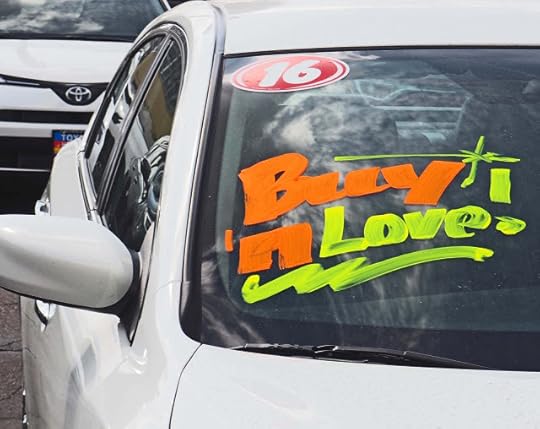
Then, at the weekend, I went to the LA Auto Show. I hadn’t been for years, and I can’t say I’d missed it much, but this seemed a reasonable time to go and see what, if anything, had changed.
It was an interesting walking experience. You walk slowly for miles, not quite lost but not quite knowing how to get where you’re going, surrounded by other slow moving, equally not-quite-lost walkers. Much of the time you’re walking on some very fancy, and I suppose industrial grade, carpet. Probably this makes the walking a bit easier.
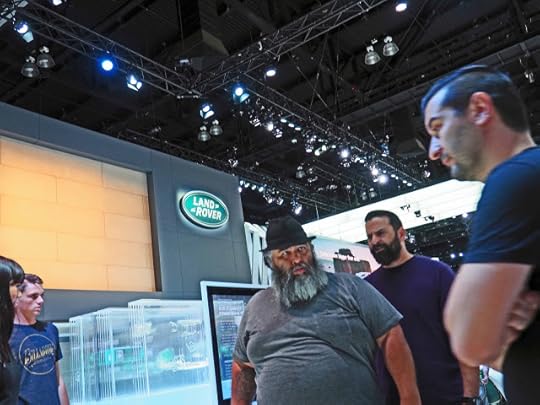
And of course there are the poor spokesmodels who have stand by the cars and probably don’t walk very far, but given those heels, their feet must be in tatters at the end of the day, though in fact there were considerably fewer of these poor women than there used to be; progress, right?
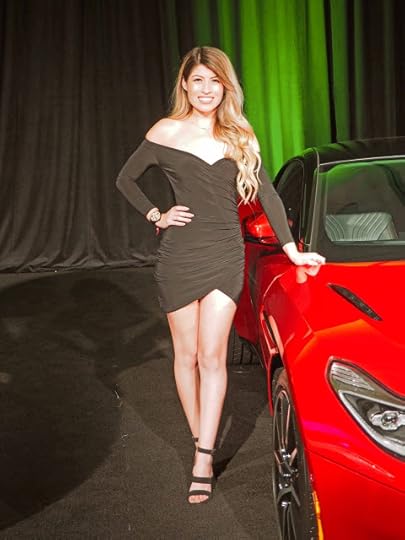
There wasn’t a whole lot of language on display at the show, though such as there was had its raw appeal:
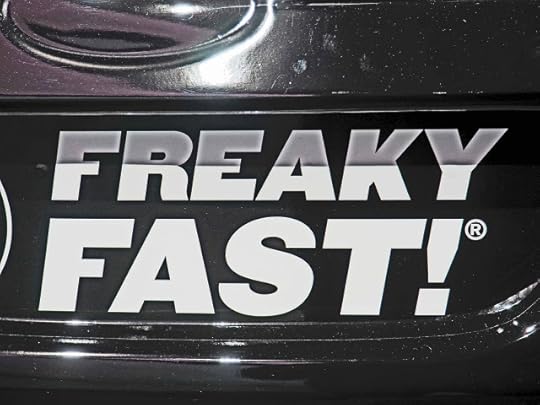
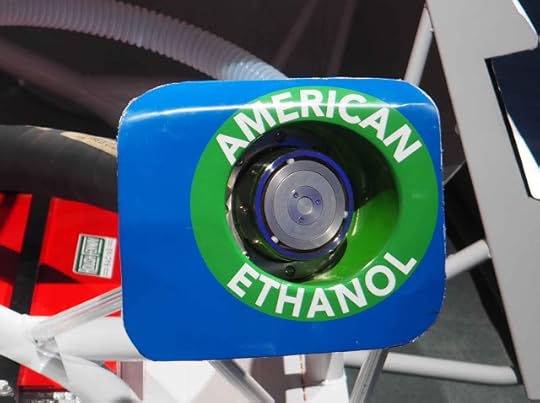
And you could also pick up some very expensively printed car brochures which were full of auto verbiage. I learn for example that the GMC Terrain Denali “is the SUV reimagined with you in mind.” Me? You’d think they’d have told me sooner, wouldn’t you? Anyway, none of this auto language was nearly as zesty or as much fun as that painted on the windshields of the cars on Hollywood Boulevard. A lesson there for somebody.

Published on December 05, 2017 14:11
November 25, 2017
WALKING WITH WORMOLD
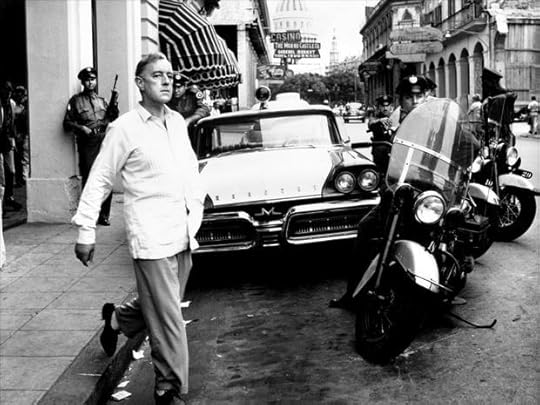
Life being the way it is, I went up to Glendale Community College to talk to Claire Phillips’s class about writing in general and my novel The Miranda in particular. This is Claire Philips.
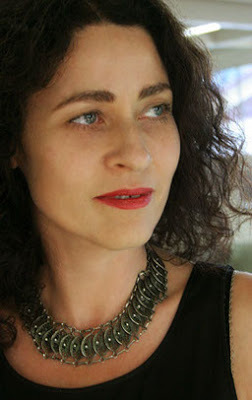
As you might expect, my novel contains a significant amount of walking, and also of keeping track of the numbers – miles per day, numbers of circuits completed, that kind of thing. You'll just have to read it. But here’s the curious part – in the Q and A Claire said she saw some parallels between my writing and that of Graham Greene, which, leaving aside the flattery, surprised the heck out of me.
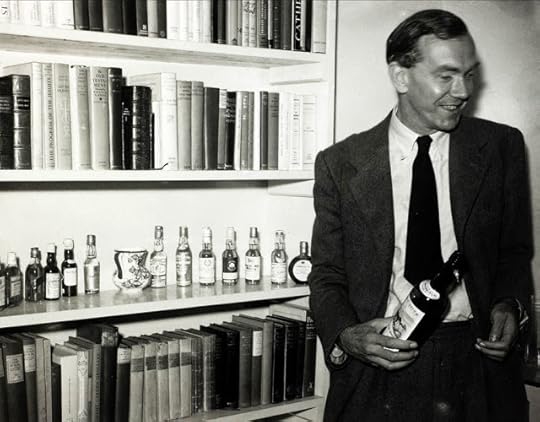
I’ve read plenty of Graham Greene in my life – it was what English people of my generation did - and although I liked his books well enough, I was never the greatest fan, and I definitely would never thought I was influenced by him.
I think the jury’s probably still out on that, however as a result, I decided to read Our Man In Havana – one of those books I’d never read but knew a certain amount about – whisky miniatures and vacuum cleaners, a central character named Wormold. Anyway, I’ve read it now (isn’t the daughter just appalling?). But perhaps the most surprising thing of all comes on the very first page, in the second paragraph:


Published on November 25, 2017 08:16
November 22, 2017
MY HEART BELONGS TO TRONA
I wasn’t planning to go to Trona at the weekend, but there I was in Ridgecrest, and Trona is just 24 miles down the road, and I couldn’t resist.
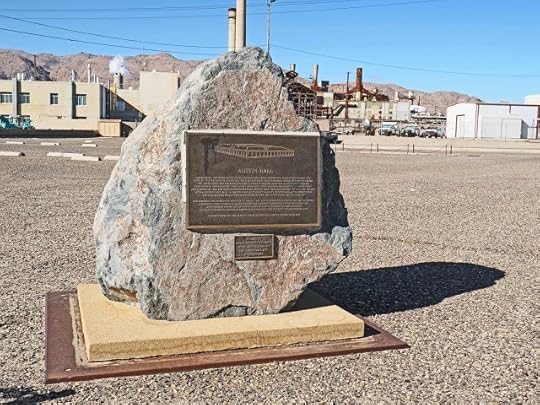
It’s hard to say exactly what Trona is. Officially it’s designated as an “unincorporated community” but that doesn’t tell you much. It’s not a desert ghost town (though it kind of looks like one) because it has a thriving industry – mineral processing – which has been there in some form, booming and busting, since the late 19th century. Today Searles Valley Minerals run the show, extracting soda ash, sodium sulfate, and various kinds of borax and salt from the not quite dry lakebed.
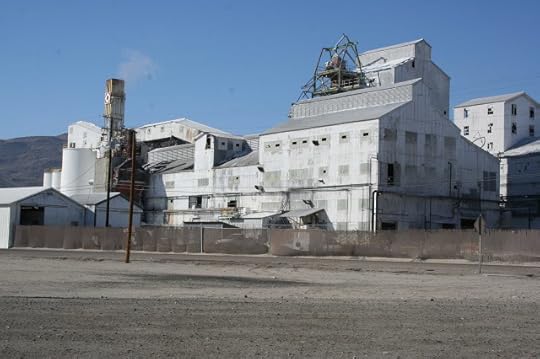
Not a lot of people live there. Most of the workers at the processing plant commute from Ridgecrest, but there is a small resident population; maybe a couple of thousand. There’s something oddly suburban about the layout of Trona, a grid of neat streets, individual houses on small plots of land. Some of the houses are abandoned, some are broken down, a few surprisingly intact. The one below is for sale - priced to move.
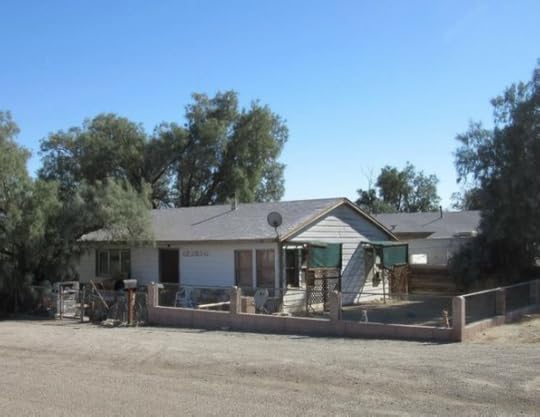
I wouldn’t say that people were necessary proud of their gardens but a certain amount of ingenuity goes into some of them. Like this rock garden:
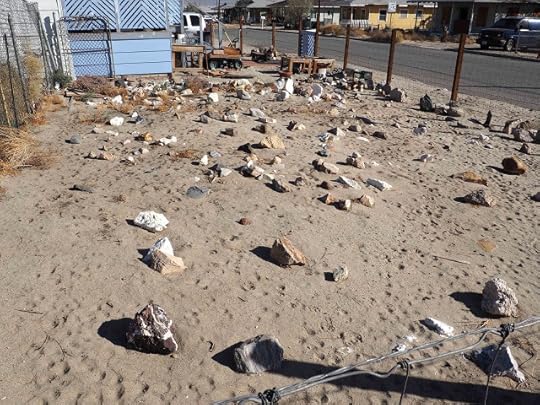
On a Saturday afternoon in November there were one or two people going in and out of the pizza joint, but otherwise the streets were pretty much deserted: a couple of kids playing football in the middle of the road, and one man walking along unsteadily in the direction of the general store. Some citizens had definitely embraced that whole “desert weirdness” thing, sometimes with their hood ornament:
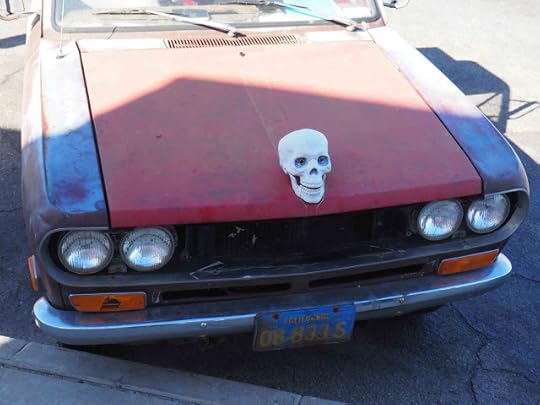
And sometimes with their yard decorations; skeletons still in place even though Halloween was some way behind us:
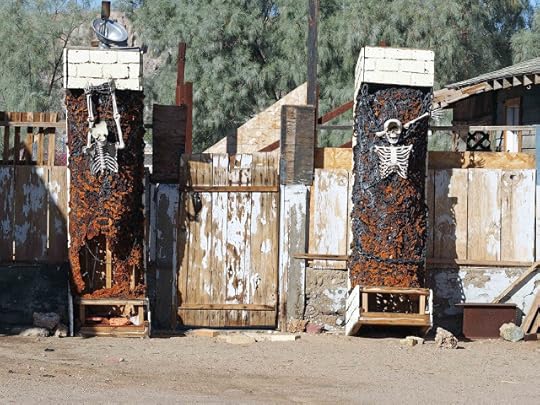
As you walk around the empty streets you hear dogs barking at you, lots of them. Sometimes they’re behind wooden fences so you can’t see them, though others are behind chain link and you definitely can. Sometimes they’re small and yappy, sometimes they're large, angry and drooling. In some cases their bark may be worse than their bite but I wouldn’t want to put it to the test.
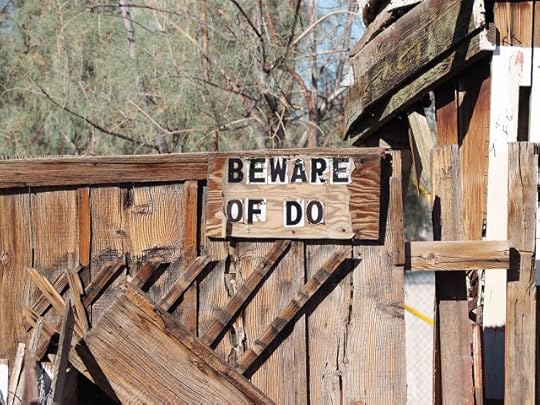
And finally there were cats. I saw a couple of strays walking the streets, timid but free in a way that those dogs weren’t, and as long as the cats stayed out of the canine-infested yards they had the run of the place. And you remember that thing in Spalding Grey’s Swimming To Cambodia where he can’t bring himself to leave Thailand until he’s had his perfect, transcendent moment?

Well, in general I’m pretty skeptical about the need to expect, much less force, an epiphany, but I had just such a moment in Trona.
I saw just one cat at first, sitting on top of an air conditioner, and then one peering round the side, and then I finally spotted the third, looking out from inside the house, finally the whole trio looking out at me, looking in at them. About as good as it gets.
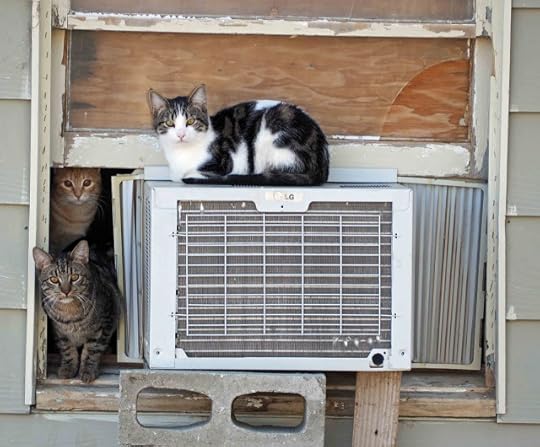


It’s hard to say exactly what Trona is. Officially it’s designated as an “unincorporated community” but that doesn’t tell you much. It’s not a desert ghost town (though it kind of looks like one) because it has a thriving industry – mineral processing – which has been there in some form, booming and busting, since the late 19th century. Today Searles Valley Minerals run the show, extracting soda ash, sodium sulfate, and various kinds of borax and salt from the not quite dry lakebed.

Not a lot of people live there. Most of the workers at the processing plant commute from Ridgecrest, but there is a small resident population; maybe a couple of thousand. There’s something oddly suburban about the layout of Trona, a grid of neat streets, individual houses on small plots of land. Some of the houses are abandoned, some are broken down, a few surprisingly intact. The one below is for sale - priced to move.

I wouldn’t say that people were necessary proud of their gardens but a certain amount of ingenuity goes into some of them. Like this rock garden:

On a Saturday afternoon in November there were one or two people going in and out of the pizza joint, but otherwise the streets were pretty much deserted: a couple of kids playing football in the middle of the road, and one man walking along unsteadily in the direction of the general store. Some citizens had definitely embraced that whole “desert weirdness” thing, sometimes with their hood ornament:

And sometimes with their yard decorations; skeletons still in place even though Halloween was some way behind us:

As you walk around the empty streets you hear dogs barking at you, lots of them. Sometimes they’re behind wooden fences so you can’t see them, though others are behind chain link and you definitely can. Sometimes they’re small and yappy, sometimes they're large, angry and drooling. In some cases their bark may be worse than their bite but I wouldn’t want to put it to the test.

And finally there were cats. I saw a couple of strays walking the streets, timid but free in a way that those dogs weren’t, and as long as the cats stayed out of the canine-infested yards they had the run of the place. And you remember that thing in Spalding Grey’s Swimming To Cambodia where he can’t bring himself to leave Thailand until he’s had his perfect, transcendent moment?

Well, in general I’m pretty skeptical about the need to expect, much less force, an epiphany, but I had just such a moment in Trona.
I saw just one cat at first, sitting on top of an air conditioner, and then one peering round the side, and then I finally spotted the third, looking out from inside the house, finally the whole trio looking out at me, looking in at them. About as good as it gets.


Published on November 22, 2017 09:20
November 14, 2017
WALKING NOW AND THEN
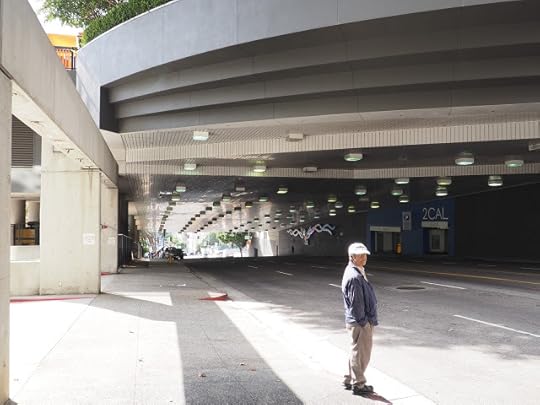
I’m always a sucker for those “then and now” photographs, that show places as they are now, compared with how they used to be. Of course it helps if they’re of a place you know, and have walked around. The example below is of Sheffield, the city where I was born and grew up, and walked around a lot, although mostly without enough paying much attention, it seems to me now.
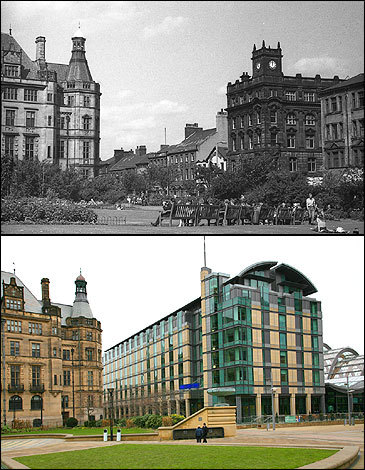
But maybe you don't have to really know the place. I only know Paris as an occasional visitor, but I’m fascinated by the work of Christopher Rauschenberg who’s done small wonders photographing the same streets that Eugene Atget photographed at the end of the 19thand beginning of the 20th century.
It’s worth noting that the current Wikipedia entry describes Atget as a flaneur. Equally, it’s worth noting how very few walkers appear in Atget’s photographs, a consequence of his using antiquated equipment and long exposures times. If people didn't hold still they became invisible.
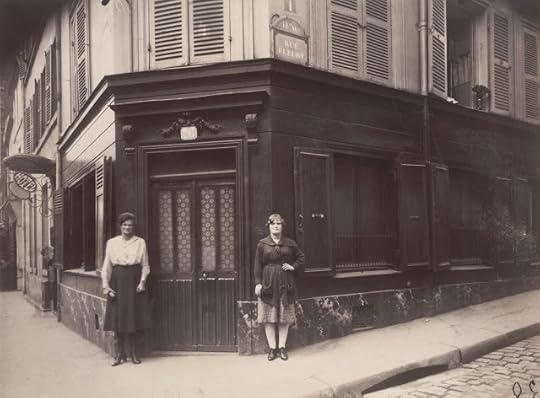
Rauschenberg’s photographs appear alongside Atget’s in a book titled Paris Changing: Revisiting Eugene Atget's Paris. Not least of the wonders is that some places seem to have changed so little.

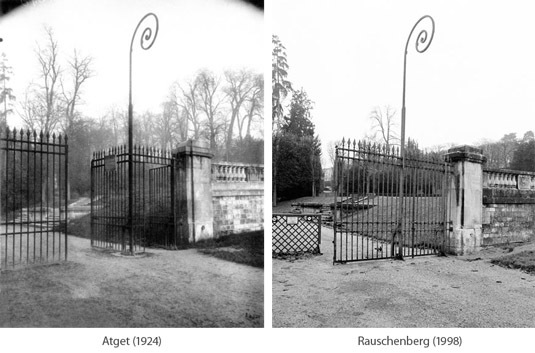
Here in Los Angeles there’s quite an industry of exploring and excavating what is, after all, a comparatively short history. The Rodney King Riots provide one rich source of material. The photographs below show Washington Boulevard at Norton Avenue and are credited to Ted Soqui and Corbis. I find myself powerfully drawn to an establishment called Fish 2Go
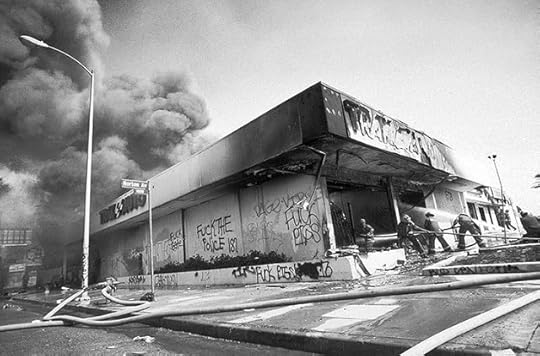
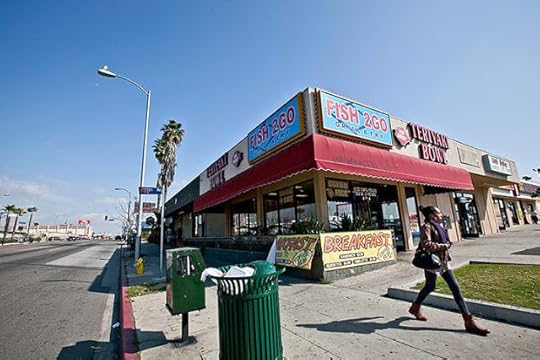
This kind of project reaches an apotheosis with Ed Ruscha’s Then and Now. It’s a book, yet simultaneously much more than a book, documenting two journeys along the complete length of Hollywood Boulevard, one in 1973 the other in 2003, photographing every building along the way. Admittedly the photographs were taken from the back of pickup truck rather than while walking, but you can’t have everything. As a book it looks like this:
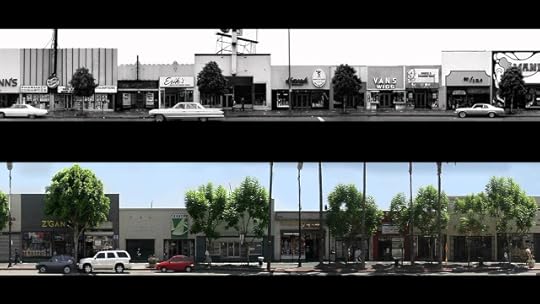
As a gallery installation like this:
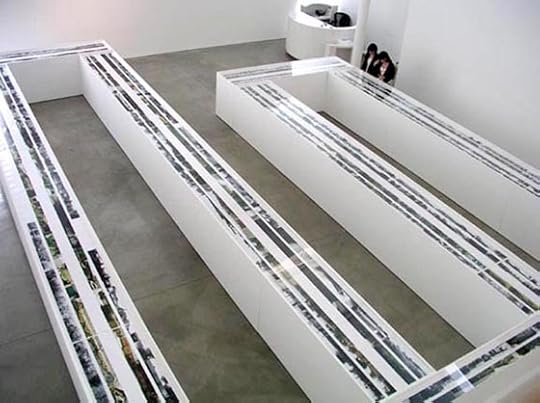
This kind of thing was on my mind because I’d been looking at a photograph of Ingrid Bergman, taken by Bill Ray for Life magazine in 1967. Captions tell us she’s walking up Olive Street in downtown Los Angeles, between 3rd and 4thStreet. Now I’m guessing this is just a photo op. I’d be surprised if she’d walked very far in those sandals – and the shopping bag is a prop surely: where would she have shopped, where would she be taking her shopping?
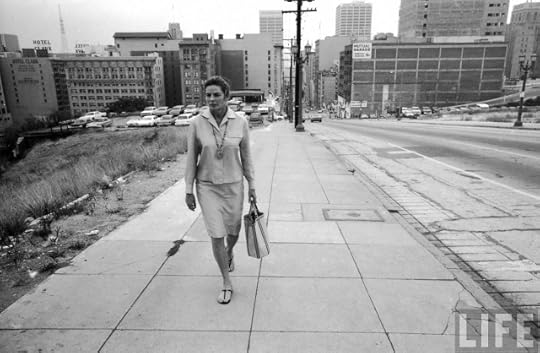
Even so, I set off to walk in her footsteps. And frankly I got to Olive Street and I was lost, or at least severely disoriented. Chiefly this is because the Omni Hotel has been built on, and to some extent over Olive Street, so that the section between 3rd and 4th Street has become a kind of tunnel.

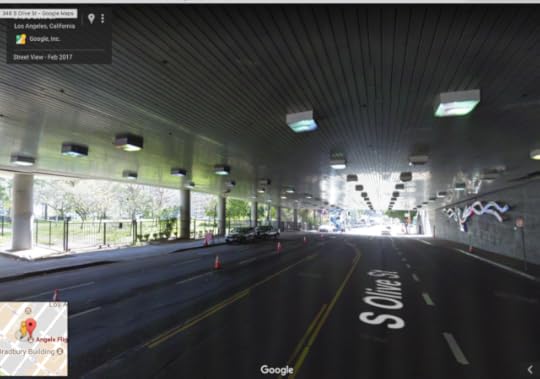
As for that patch of waste land off to the left in the Ingrid picture – a razed bit of Bunker Hill - that’s still there, now greener and better looked-after but also behind a fence, and patrolled by a security guard who, at least when I was there, glared out at anybody who looked in. The land slopes down, on the opposite corner, to an entrance of the Pershing Square metro station, which is actually some way from Pershing Square proper.


In the 1970s Ingrid Bergman lived in London. The online caption for the picture below says she’s here walking along New Cavendish Street, but I’m not quite convinced of that.
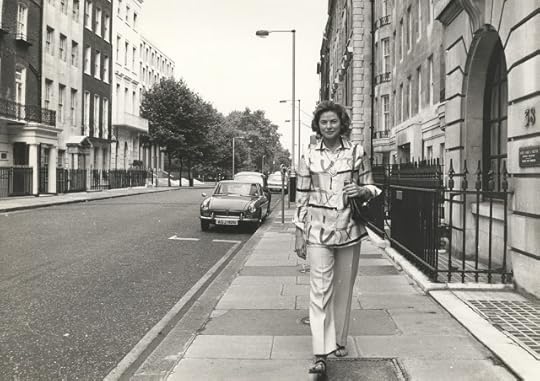
And here she is in Rupert Street Market – no shopping bag this time, when you’d have thought she might need one.
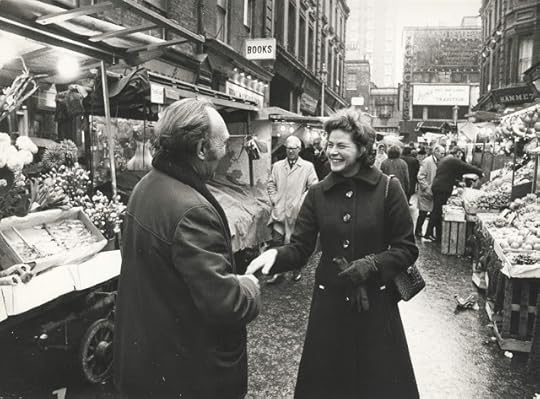

Published on November 14, 2017 18:07
November 13, 2017
THE FUGUE IS IN THE HEART
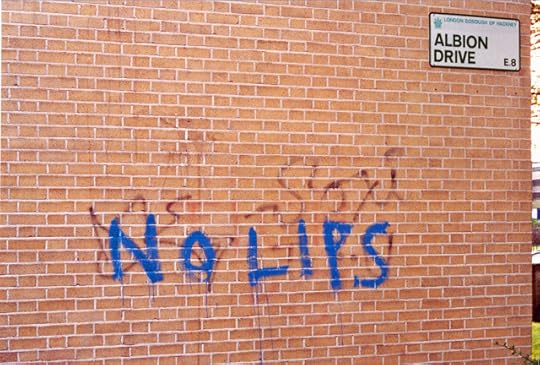
Iain Sinclair, talking at a dinner given by The Idler magazine in November:
“It’s about wandering. It’s not a kind of idle wandering; I gave up on the term flâneur a while back. I went for fugan instead, like the mad walkers of the 19th century who took off on enormous journeys across France. There was a plumber from Bordeaux who walked out the door one day and finished up in Moscow. Then some dreadful writers took up with it and within a few months, the middle classes were all on the road pretending to be fugues. I feel a bit like that now with this whole walking fetish. Now everywhere you go, you find people doing strange conceptual walks, taking photographs of road signs and trying to get arrested in the car park of IKEA.”
Ouch.

Published on November 13, 2017 09:48
November 10, 2017
OF WALKING AND TROTTING (THAT'S A TURKEY REFERENCE)

I was walking in El Cerrito, which you may or may not know, is a very “suburban” suburb in the East Bay, across the water from San Francisco, a couple of BART stops north of Berkeley. I know we’re all supposed to hate the suburbs but I never do. I find them endlessly fascinating in subtle, sometimes minimalist, ways. Here you can define yourself as a maverick by what you grow in your front garden

or what kind of door you have on your garage.

El Cerrito was founded in 1906 by people who’d fled San Francisco because of the earthquake, though the majority of the homes I saw look as though they were built in the 1940s or 50s, modest but not poor, the architecture not all that exciting, but the houses are well kept and with the occasional bit of eccentricity here and there.
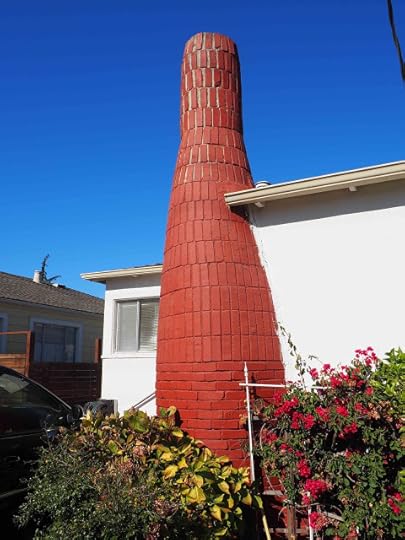
My destination, to the limited extent that I had one, was Downhome Music (“serving you with roots music since 1976”) –

but it wasn’t open yet when I got there, so I had a not especially ambitious walk around the neighbourhood, and I came cross this paving stone:
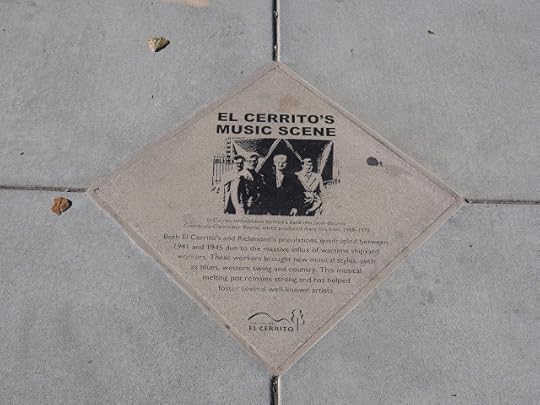
I don't know if you can read it very well, but it says that Credence Clearwater Revival came from El Cerrito which was a surprise to me. I'd always assumed without giving it any thought, or caring about it much, that Credence were southern boys, but what did I know? The Fogerty boys did indeed grow up in El Cerrito, though they were born in Berkeley.

Still, the biggest name in El Cerrito music is Metallica. They lived there between 1983 and 1986 in a house at 3132, Carlson Boulevard, known as the Metallica Mansion, and it was there, mostly in the garage, that they composed the two albums Ride the Lightning and Master of Puppets. The garage has been demolished but in 2016 the city proclaimed the band as a “cultural institution,” and they had a ceremony down at the house.
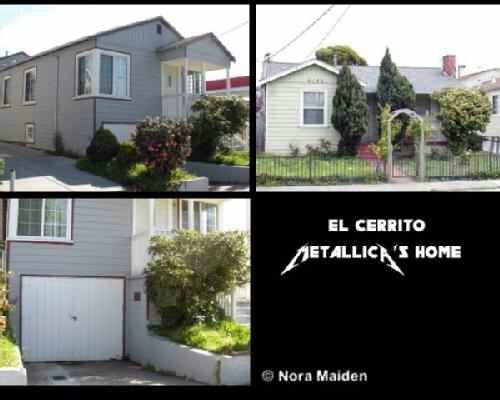

In fact, without knowing it, I did come within a couple of blocks of the house, and if I had known, I’d definitely have gone and had a look at it, though I imagine the current inhabitants get a bit fed up with that kind of thing.

The suburbs of course, especially on a weekday are remarkably free from other people, even other walkers, which means you can have a good nose around, and take some photographs, and nobody bothers you, or even notices you.

You know, the streets of El Cerrito were empty enough that even wild turkeys could stroll around without being bothered. I rather like that in a suburb.

In due course, Downhome Music opened and in due course I bought an album by Juke Boy Bonner, a man from Texas but with at least some connection to El Cerrito. The album was Life Gave Me a Dirty Deal (which apparently it really did) on Arhoolie Records, a label founded in El Cerrito in 1960. There’s a song on the album titled “ Stay Off Lyons Avenue” which contains some advice about walking, although actually in Houston:
“You wanna walk around on Houston’s streetsYou like to be real wiseAnd stay off of Lyons Avenue streetAnd don’t go down on Jensen nowhere
Because you’re living on luck and a prayer.”

Published on November 10, 2017 17:25
OF WALKING AND TROTTING (TURKEY REFERENCE)

I was walking in El Cerrito, which you may or may not know, is a very “suburban” suburb in the East Bay, across the water from San Francisco, a couple of BART stops north of Berkeley. I know we’re all supposed to hate the suburbs but I never do. I find them endlessly fascinating in subtle, sometimes minimalist, ways. Here you can define yourself as a maverick by what you grow in your front garden

or what kind of door you have on your garage.

El Cerrito was founded in 1906 by people who’d fled San Francisco because of the earthquake, though the majority of the homes I saw look as though they were built in the 1940s or 50s, modest but not poor, the architecture not all that exciting, but the houses are well kept and with the occasional bit of eccentricity here and there.

My destination, to the limited extent that I had one, was Downhome Music (“serving you with roots music since 1976”) –

but it wasn’t open yet when I got there, so I had a not especially ambitious walk around the neighbourhood, and I came cross this paving stone:

I don't know if you can read it very well, but it says that Credence Clearwater Revival came from El Cerrito which was a surprise to me. I'd always assumed without giving it any thought, or caring about it much, that Credence were southern boys, but what did I know? The Fogerty boys did indeed grow up in El Cerrito, though they were born in Berkeley.

Still, the biggest name in El Cerrito music is Metallica. They lived there between 1983 and 1986 in a house at 3132, Carlson Boulevard, known as the Metallica Mansion, and it was there, mostly in the garage, that they composed the two albums Ride the Lightning and Master of Puppets. The garage has been demolished but in 2016 the city proclaimed the band as a “cultural institution,” and they had a ceremony down at the house.


In fact, without knowing it, I did come within a couple of blocks of the house, and if I had known, I’d definitely have gone and had a look at it, though I imagine the current inhabitants get a bit fed up with that kind of thing.

The suburbs of course, especially on a weekday are remarkably free from other people, even other walkers, which means you can have a good nose around, and take some photographs, and nobody bothers you, or even notices you.

You know, the streets of El Cerrito were empty enough that even wild turkeys could stroll around without being bothered. I rather like that in a suburb.

Published on November 10, 2017 17:25
Geoff Nicholson's Blog
- Geoff Nicholson's profile
- 55 followers
Geoff Nicholson isn't a Goodreads Author
(yet),
but they
do have a blog,
so here are some recent posts imported from
their feed.



